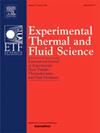离心泵内非定常粘性油流的时间分辨PIV测量
IF 3.3
2区 工程技术
Q2 ENGINEERING, MECHANICAL
Experimental Thermal and Fluid Science
Pub Date : 2025-07-08
DOI:10.1016/j.expthermflusci.2025.111558
引用次数: 0
摘要
离心泵是许多人类活动必不可少的,占全球电力消耗的相当一部分。然而,尽管经过了几十年的研究,人们仍远未完全了解泵叶轮内的流动及其对性能的影响,特别是当流动涉及比水更粘稠的流体时。在此背景下,本文报道了使用时间分辨粒子图像测速(TR-PIV)研究14cp粘度矿物油在径向叶轮透明泵中的流动的实验。我们发现:(1)在低流速下,涡旋的位置与流体性质有关;(ii)在高流速下,油流沿径向排列,而水流则沿叶片弯曲方向流动;(3)油的速度分布近似为抛物线,而水的速度分布较为平缓;(iv)速度矢量相对于叶片曲率的平均偏转角随黏度变化显著;(5)与一般预期相反,油的湍流动能比水高4倍;(6)涡旋周期性地形成并以与转速成正比的频率消散。我们的研究结果为泵中粘性流体的流动提供了新的见解,为泵的设计和安装提供了有价值的信息。本文章由计算机程序翻译,如有差异,请以英文原文为准。
Time-resolved PIV measurements of an unsteady viscous oil flow in a centrifugal pump
Centrifugal pumps are essential for many human activities, accounting for a considerable portion of the global electricity consumption. However, despite decades of study, the flow within the pump’s impeller and its effects on the performance are far from being fully understood, particularly when the flow involves fluids more viscous than water. In this context, this paper reports experiments using time-resolved particle image velocimetry (TR-PIV) for investigating the flow of a 14-cP-viscosity mineral oil in a transparent pump with radial impeller. We found that: (i) at low flow rates, the positions of vortices depend on the fluid properties; (ii) at higher flow rates, the oil flows aligned in the radial direction, while the water flows following closely the blade curvature; (iii) the velocity profiles for the oil are approximately parabolic, whereas those for water are flatter; (iv) the average deflection angle of the velocity vectors relative to the blade curvature changes significantly with viscosity; (v) contrary to common expectation, the turbulent kinetic energy is up to four times higher for oil than for water; (vi) vortices are periodically formed and dissipated with a frequency proportional to the rotational speed. Our results provide new insights into the flow of viscous fluids in pumps, with valuable information for their design and installation.
求助全文
通过发布文献求助,成功后即可免费获取论文全文。
去求助
来源期刊

Experimental Thermal and Fluid Science
工程技术-工程:机械
CiteScore
6.70
自引率
3.10%
发文量
159
审稿时长
34 days
期刊介绍:
Experimental Thermal and Fluid Science provides a forum for research emphasizing experimental work that enhances fundamental understanding of heat transfer, thermodynamics, and fluid mechanics. In addition to the principal areas of research, the journal covers research results in related fields, including combined heat and mass transfer, flows with phase transition, micro- and nano-scale systems, multiphase flow, combustion, radiative transfer, porous media, cryogenics, turbulence, and novel experimental techniques.
 求助内容:
求助内容: 应助结果提醒方式:
应助结果提醒方式:


